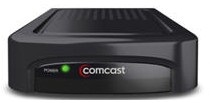Comcast Tests Guide For DTAs, Preps HD Model
Comcast is looking to extend its digital transport adapters -- low-cost devices for converting digital TV for viewing on older analog televisions -- in at least two new directions: The MSO plans to roll out an HD version of the DTAs and is even testing a way to deliver program-guide info to them.
The nation's biggest cable operator has distributed more than 18 million DTAs to customers to date as part of a $1 billion multiyear project to eliminate analog cable channels, a conversion that was about 75% complete at the end of 2010.
The DTA initiative, which has the internal code name "Project Cavalry," lets Comcast eliminate 35 to 50 analog channels in its expanded basic lineups. That reclaims as much as 300 MHz or more of spectrum, which the operator is using to provide more video-on-demand, more HD channels and faster Internet speeds. In fact, Comcast's marketing program for customers about the project is called "World of More."

"All of this means we're delivering better products to our customers, more high-def and foreign language programming, up to 25,000 on-demand choices, better guides, improved DVR functionality, more interactivity, as well as higher speeds for our high-speed Internet customers," Comcast CEO Brian Roberts said on the operator's February earnings call.
Comcast is now looking to use the DTA as a relatively inexpensive way to deliver HD programming to customers who don't want a DVR or other advanced features.
The HD models will be "universal" DTAs, meaning they will work with Motorola and Cisco Systems conditional access systems, Comcast senior director of corporate communications Jenni Moyer said. The HD uDTAs would include radio-frequency remotes (which don't require line-of-sight as infrared remotes do) and would have an HDMI output.
Comcast hasn't disclosed when it plans to begin deploying the HD uDTAs, nor has it identified the supplier, Moyer said. But she noted that the Federal Communications Commission last October revised its CableCard rules to allow operators to deploy one-way HD DTA devices that have integrated security functions.
Multichannel Newsletter
The smarter way to stay on top of the multichannel video marketplace. Sign up below.
Among other operators, Cable One has deployed HD DTAs manufactured by Digital Multimedia Technology that use integrated security from Nagravision in Dyersburg, Tenn., Light Reading has reported.
On another track, Comcast is testing out an electronic guide, code-named "Atom," which would provide access to program listing info comparable to what is available through conventional digital set-top boxes, Moyer said. The guide info would be delivered in the same way the DTAs' firmware is updated. Currently, the SD adapters -- sourced from Cisco Systems, Motorola, Pace and Technicolor -- provide only channel name and number.
Comcast won't disclose exactly what it pays for the DTAs, but the SD versions are under $50 apiece, less than half the cost of conventional digital set-tops. They're also smaller, measuring roughly 3 by 5 inches or less.
Meanwhile, while Comcast has suggested its iPad app could be used to change channels on a DTA by "force tuning" them, currently that functionality is not supported because the DTAs don't have an out-of-band tuner, Moyer said.
In comments filed with the FCC last year on the CableCard issue, Comcast said making the Xfinity TV app able to change channels on the DTAs would "require significant new standardization and development work. But even assuming that the Xfinity remote control application could be developed for the DTA, that would not make the DTA an interactive device."
